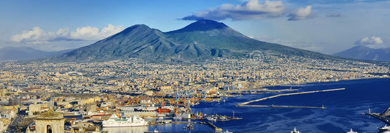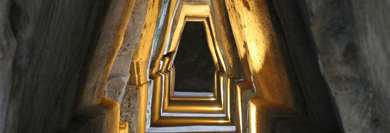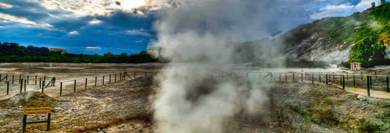Excursions
Autoservizi Borrelli offers to his Customer excursions to the most beautiful resorts of Campania. We offer also personalized solutions.

Pompei

Ercolano

Amalfi Coast

Vesuvius

Paestum

Caserta Palace

Cumae

Solfatara

Sorrento

"Campo Pompeiano", now Pompei Valley located at south of Vesuvius, irrigated on the right from Sarno river and on the left from Canal of Sarno, fertile and sheltered from the Appennine Mountains, it extends between two mounts: the Vesuvius with its majestic crater and its wonderful Park, and the Gauro with its three green summit. Center of the wonderful Sanctuary of the Madonna of Pompei, in the last century counted few inhabitants, but just this disowned valley was chosen from the Vergine to increase the faith and the charity. Today beyond to being a pilgrimage place, Pompei offers to its visitors the possibility to visit the most important "Excavations of Pompei" without disdain an enlivened nocturnal life.

Certainly of Greek origin, as indicate by its place-name (from the greek Herakleion, lat. Herculaneum) and the type of town-planning, much similar one to that one of the neighbor Neapolis (Naples), the city of Ercolano, founded, according to the tradition, just from the mythical Eracle (Herakles-Hercules), had to endure, already from the end of VI century a.C., the hegemony of others and more powerful Greek centers; conquered then from the overwhelmed Sanniti and therefore from the Roman, bacame finally Municipium in the 89 B.C. Small center of transit between Naples and the south of the Peninsula located to the extreme slopes of the Vesuvio, with a population of 4/5000 inhabitants, Ercolano had, with the exception of Pompei - healthy mercantile city - a very more detached connotation residential one, as deduced by the presence of the "Excavations of Ercolano" that are the destination of thousands of tourists every year.

In no place the colours shine various and limpid like in the Amalfi Coast, for ever the most elegant destination of prestigious visitors. Mounted like unparalleled gems in the most precious one diadema, the small villages scattered on the coast captures every tourist, also the most crafty. Here all becomes symbol: the rich earth of citruses, the sea with the most incredible tonalities of blue and green, the evocative little beaches, the small islands, the wonderful landscapes, agglomerates of small white, rose, yellow houses around little harbours. In the storees of local handicraft incomparable objects, for their beauty and particularitities, attend you.

The Vesuvio is classified like an active volcano. It is located at 10 km to east south - east of Naples and it is separated from the gulf of Naples from a tightened flat coastal strip. The Vesuvio is composed from lave and detritus, it is poligenico, because it has risen thanks to several successive eruptions. It is originated like insular volcano in the marine inlet that in the Eocene penetrated within the limestone reliefs of "Appennino Campano", joined to the mainland in the Pliocene, because of a strong raising of lands, abundant taps of lava and of other solid fire materials that would have carried the cone to approximately 2300 meters. A strong eruption taken place in the prehistory would have shortened it to a height similar to the actual, leaving an enormous crater of outbreak and collapse to the top.

Paestum was founded from the Greeks in the 600 B.C. Later called Poseidonia (this was the ancient name) was occupied from the Lucani (400 a.C.) and finally from the Roman who gave its actual name. At the end of the 500 A.D., because of a deforestation of the surrounding mounts zones, there were a silting up of the rivers's mouths that carried to unhealthiness of the territory. The malaria forced the population to abandon the plain and to go in the near inhabitated area, first of all Capaccio. Only many centuries after, in 1752, during the reconstruction of the modern road, were discovered again the ancient ruins. Since then, Paestum has become privileged destination from the tourists of all the world in vacation in Italy.

Completely open, the Caserta Palace was intentional from CARL III. The plan came entrusted to Luigi Vanvitelli and the construction was begun in 1752 and go on until 1774. The inner rooms, the royal scale, the chappelle rich of polychrome marbles, the precious paintings, the theatre rich of fantasy and architectonic inspiration and its huge garden with the fountains and water games, make the Caserta Palace one of the real residences more prestigious and important of Europe.

Cuma was the most ancient and northern Greek colony; this colony was founded from greeks coming from the island of EUBEA that, little before the 750 B.C., were allocated to PITHECUSA. In this island they gave life to a industrial and commercial center attended also from syrian and phoenices merchants; Cuma was a point of support for the land commerce with the territories that were found to the inside of the continent. The Greek colonizers chose the place in order to found Cuma for strategic reasons: the fortress of Cuma, in fact, appeared impregnable and this allowed to control all the surrounding territory easily.

The volcano of Solfatara lies from about 4000 years at the center of the Flegrei Fields. The volcanic building, that with its oriental external depositors closes to the west the Conca of Agnano, falls back entirely in the territory of the Municipality of Pozzuoli. More young of Agnano's volcanos and birth previous of the Astroni, the Solfatara continue to offer the show of an area of active vulcanism: fumarole manifestations, sismics tremors and cyclical deformation of the ground constitute the characteristic elements of the volcano dynamics. Monitored from a thick net of instruments, the Solfatara is considered natural laboratory from the scientists of geologic studies, but also continuous danger for the adjacent urbanized areas.

The city of Sorrento is located at south of Gulf of Naples, along the "Penisola Sorrentina" which get the name from it. According to the legend the name derive from the mythic mermaid, half woman and half fish, who drive the sailors to be wreched against her rocks. Probably of greek origin, after much vicissitudes it became "Duckedom of Sorrento", and in 1137 was incorporated in the Norman Reign, then it follow the politic destiny of Naples. In the hystoric center there are the Neogotic Cathedral and the church of Saint Francesco from Assisi, with an important little fourteenth-century cloister. The local economy is based mainly on the quality, cultural and bathing tourism, on the agriculture (citrus fruits, vine, nuts, olive), on the food industry and on the inlaid wood crafts. In the street of the center the clothes shop-windows suggest the trend laws.
